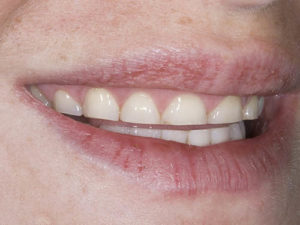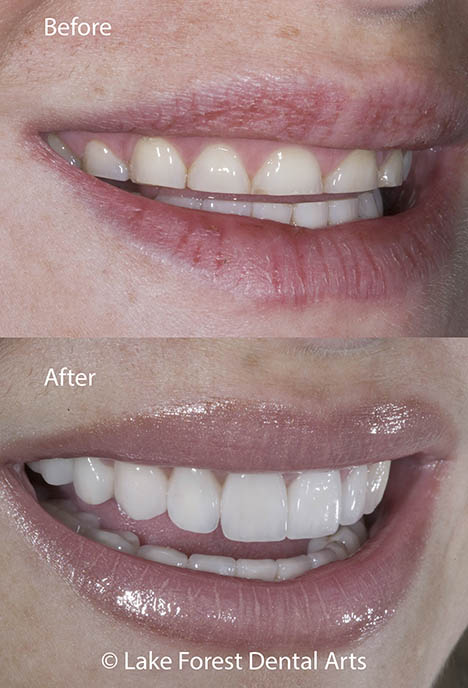
Upper front teeth normally are 20% longer than they are wide. If this length to width ratio is closer to 1:1, the teeth will appear short or boxy and can make the smile appear unbalanced and not symmetrical. The appearance of short teeth is caused mainly by heavy wear, how the gum lays over the tooth crown, microdontia, erosion, or from a poor orthodontic arrangement or jaw position. The front teeth should be the main focal point of a smile, delicately framed by the gums. This article explores the most common causes of short teeth. A review is included of treatment options to restore the health, function, and appearance of your smile.
Bruxism wear will cause short teeth
Commonly referred to as chronic grinding or clenching, bruxism places excessive pressure on natural tooth surfaces. While this typically happens during sleep, it can also occur during waking hours, especially during times of stress and anxiety.
Bruxism and clenching can lead to a host of serious oral and overall health issues. These problems include TMJ disorder, fractured teeth, difficulty chewing, and dental misalignment. Another serious consequence of bruxism is enamel loss. Over time, the constant friction and pressure can wear down the surfaces of the enamel, resulting in short natural teeth.
Treatment for Bruxism
The most common treatment for bruxism is an oral appliance. Typically, a custom mouth guard is only worn while you sleep, though some individuals may require daytime wear, as well. Custom mouth guards offer optimal protection compared to store bought versions. They are more comfortable and can address each patient’s unique dental needs more effectively.

This patient had extremely heavy wear from bruxism. Her gums showed prominently when she smiled. Her makeover included a gum lift and a combination of crowns and cosmetic veneers.
Short teeth can be caused by altered passive eruption
Altered passive eruption is not a disease or disorder, but rather a condition. It is characterized by an abnormal relationship between the gum tissue and the supporting bone. This condition is frequently referred to as a gummy smile.
Typically, the gum margin is close to the edge of the enamel. This edge is where the clinical crown meets the root. Excess gum tissue covers more of the crown. As a result, the teeth appear short.
Treatment for excessive gum tissue
The most common treatment for a gummy smile is cosmetic crown lengthening or a gum lift. During this procedure, the extra gum is removed, and the gum line is reshaped for a more balanced, natural looking appearance.
To prevent gum tissue regrowth, minimal amounts of supporting bone may need to be removed as well. This procedure is generally completed by a gum specialist.
In some cases, crown lengthening is combined with ceramic veneers for comprehensive results. However, many patients find that crown lengthening offers impressive results on its own.
In severe cases, braces or surgery may be indicated. If the condition is primarily due to overactive lip muscles, BOTOX® injections can relax the lip and improve overall appearance. Your dentist can help you find a pain free treatment that’s right for you.
Altered Active Eruption
Altered active eruption also makes the smile appear gummy. This condition occurs when a tooth does not fully emerge or erupt. This leaves some of the crown below the bone. In other words, the main difference between the two is the position of the tooth in its socket.
Treatment recommendations
The treatments for both types are quite similar. In the case of crown lengthening, small amounts of bone will almost certainly be removed.
Once the bone has been reshaped, any extra gum is removed, and the remaining soft tissue is re-positioned and sutured into place.
During a consultation with your dentist, he or she can help determine if orthodontic treatment or oral surgery is necessary.
Microdontia
In some instances, small teeth are due to a genetic condition called microdontia. Patients with this condition have teeth that are smaller than normal.
Microdontia is typically treated with restorative dentistry. Porcelain veneers, crowns, dental bonding , and dental implants are the most popular cosmetic dentistry options. In some cases, orthodontics may be necessary.
Learn more about cosmetic dental treatments for short teeth
Short teeth may be caused by several different factors, including erosion, wear, excess gum tissue, or genetic conditions. Short can have an impact on appearance, function, and health. To learn more about these conditions and the dental treatment options cosmetic dentists use to address them. We invite you to consider a different and more comprehensive dental experience by contacting us.
